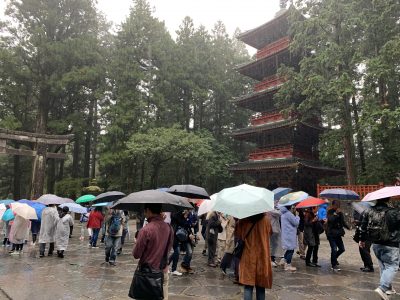If you have followed the news a bit over the last few years, you probably already know that Japan is quite prone to certain natural disasters. Tsunami and large earthquakes are thankfully very rare. But it is not unlikely to experience a small earthquake or a typhoon while you are in Japan. Let’s learn a bit more about tsunami and typhoon in Japan.

Tsunami
Because Japan is located in the Ring of Fire, an area that is known for its high tectonic and volcanic activity, there are often small earthquakes in Japan and occasionally there are larger quakes and volcanic eruptions as well. A very large earthquake can cause huge tidal waves, called tsunami. The last very large tsunami in Japan happened in 2011, during the big earthquake northeast of Japan.
Tsunami are high tidal waves generated by a shift in the ocean floor, which is in most cases caused by an earthquake. Many Japanese coasts have experienced tsunami damage at some point. The Sanriku coast in the Tohoku region has particularly suffered huge damage after the quake in 2011. The reason, scientists assume, is the formation of rigged coastline consisting of a multitude of narrow and complicated bays, which can make tsunami waves even higher.
Coastal areas in Japan always have tsunami evacuation route signs around the area, so that even when you are not from the area you will know where to evacuate to if the tsunami alarm would go off while you are there. Finding higher ground is always the first thing you should do in such a case. Luckily, the chance it will hit just when you are there is extremely small, but it is still good to be aware of where to go should the alarm start to sound.
Typhoons
A threat you are more likely to encounter during a trip to Japan is a typhoon. They happen between June and November. So if you want to be nearly 100% certain to avoid typhoons, it is better to come during winter or spring. The peak season for typhoons is between August and October.
Many people wonder what exactly the difference is between typhoons and hurricanes. A hurricane is a tropical cyclone that developed in the North Atlantic Ocean or in the Indian Ocean. And is defined as a rainstorm with a maximum wind speed of over 32.7m per second. A typhoon is a tropical cyclone that developed in the western part of the North Pacific Ocean. And is defined as a rainstorm with a maximum wind speed of over 17.2m per second. The origin of word of the typhoon is said to be the Chinese word ‘taifung’ which means ‘big wind’.
Roughly speaking, 4 typhoons hit Japan annually. The average number of typhoons born in the western part of the northern Pacific ocean is 27 per year. Not all of them head for Japan because of the influence of seasonal upper layer winds that move typhoons. This is why there will often be predictions of typhoons landing in Japan that will not come true.
If it does, however, make landfall in the area where you are staying at that moment, you should make sure you are indoors when it hits. Typhoons are only dangerous if you are outside, or if you are near an area that is prone to flooding. The typhoon itself usually only lasts for around 12 hours in one area. But if it hits a city directly the disruption to the public transportation system lasts a bit longer.
Your Japan Tour
As seasoned Japan experts, we don’t just create perfect Japan package tours but also assist you if something would happen during your trip. Traveling through a licensed travel agent like us will ensure that you will get the right support. Check out our group tours and private tours, or contact us to start planning your unforgettable holiday to this fascinating country. Japan is full of once-in-a-lifetime experiences, culture, history, nature, and delicious food!
